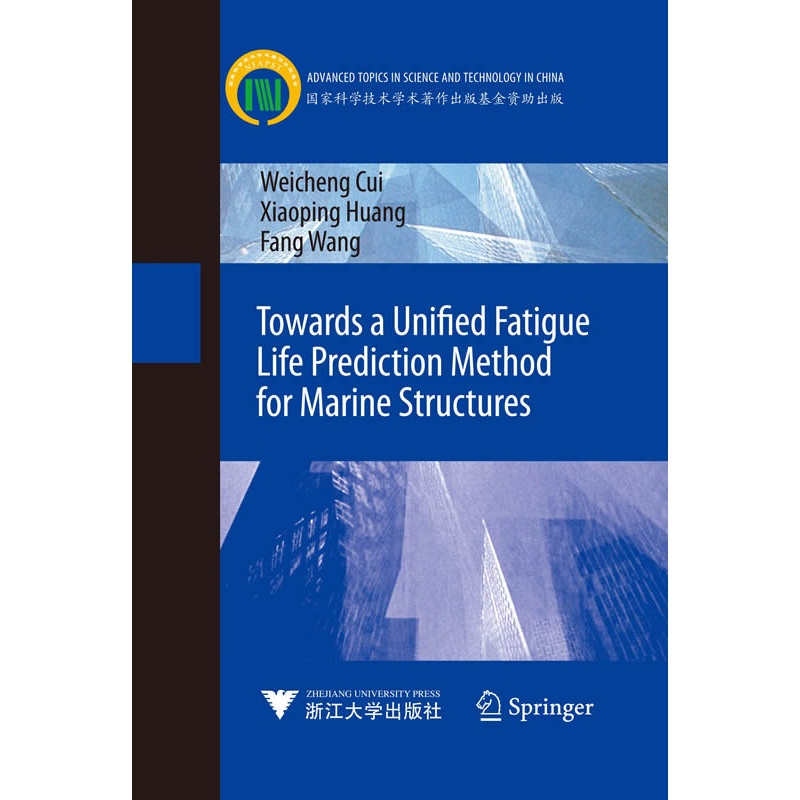 [内容简介]
[内容简介]
目前的海洋结构物设计规范由于不能考虑多个对疲劳寿命有重要影响的因素,其预报结果与实际有很大差距。下一代的疲劳寿命预报方法必须是基于裂纹扩展理论的统一方法。崔维成、黄小平、王芳编著的《海洋结构物疲劳寿命预报的统一方法(英文版)》集中介绍我们提出的疲劳寿命预报统一方法的思想、需要解决的关键技术问题以及我们已经取得的部分研究成果,并对其在工程实际问题中的应用进行演示。
[目录]
1 Introduction
1.1 Fatigue Problems in Marine Structures
1.2 Current Practices of Fatigue Strength Assessments and TheirDeficiencies
1.3 Historical Overview of Metal Fatigue
1.4 FLP Methods
1.4.1 CFD Theories
1.4.2 FCP Theories
1.5 The Layout of the Book
References
2 Current Understanding of Fatigue Mechanisms of Metals
2.1 Introduction
2.2 Different Phases of the Fatigue Life
2.3 Crack Initiation Mechanisms for Different Metals
2.3.1 Definition of a Crack Initiation
2.3.2 Fatigue Crack Initiation in Slip Bands
2.3.3 Crack Initiation Along the Grain Boundary (GB)
2.3.4 Crack Initiation at Inclusions
2.3.5 Slip Band and Dislocation in Single Crystal Metal
2.3.6 Slip Band and Dislocation in Polycrystal Metal
2.3.7 Fatigue Mechanism of Ultrafine-Grained Materials
2.4 FCP Mechanisms
2.4.1 Stage I FCP
2.4.2 Stage II Crack Growth and Fatigue Striation
2.5 Some Important Issues in Crack Growth
2.5.1 Short Crack
2.5.2 Crack Closure
2.5.3 Effect of Loading Sequence
2.5.4 Surface Effects
2.5.5 Environmental Effects
2.6 Fatigue Crack Growth Mechanism of Small Defects
2.6.1 Engineering Initial Crack Size of Structures
2.6.2 Definition of Short Crack and Long Crack
2.6.3 Crack Growth Threshold and Intrinsic Crack Length
2.6.4 Equivalent Crack Length for Short and Long Crack
2.7 Summary
References
3 Current State-of-the-Art of UFLP
3.1 Introduction
3.2 Unified Approach for Three Regions of FCP
3.3 Unified Approach to the Stress Ratio Effect or Mean Stress Effect
3.4 Unified Approach for Long- and Physically Short-Crack Growth
3.5 Unified Approach for Initiation and Propagation
3.6 Unified Approach for High and Low Cycle Fatigue
3.7 Unified Approach for Fatigue and Creep
3.8 Basic Ideas of Our UFLP Method
3.9 Summary
References
4 Basic Concepts of Fracture Mechanics
4.1 Introduction
4.2 Type's of Cracks
4.3 Types of Opening Modes for a Cracked Body
4.4 SIFs
4.4.1 Definition
4.4.2 Calculation Methods of SIFs
4.4.3 Typical Examples of SIFs
4.4.4 Plasticity Limitations of the SIFs Based on LEFM
4.4.5 Extensions of the SIFs Based on LEFM
4.5 Fracture Toughness
4.5.1 Definition
4.5.2 Testing
4.5.3 Trends
4.6 Crack Tip Plasticity
4.6.1 Plastic Zone for Plane Stress
4.6.2 Plastic Zone for Plane Strain
4.6.3 Plastic Zone Under Real Stress State
4.7 Summary
References
5 Development of a UFLP Method for Marine Structures
5.1 Introduction
5.2 A General Procedure for the UFLP Method
5.2.1 The General Function Format of the Fatigue Crack Growth Rate Curve for the UFLP Method
5.2.2 Calculation of Fatigue Life
5.3 Development of a Unified Fatigue Crack Growth Rate Model
5.3.1 The Crack Growth Rate Model for Constant Amplitude Loading
5.3.2 The Improved Crack Growth Rate Model Under VA Loading
5.3.3 Establishment of Cycle-by-Cycle Integration Procedure
5.3.4 Discussion of Model Parameters
5.4 Engineering Approaches to Determine the Parameters in the Improved Model
5.4.1 General Methods to Estimate the Model Parameters
5.4.2 Estimation Method from Crack Growth Rate Data
5.4.3 Estimation Method from a-N Curve
5.4.4 Estimation Method from S-N Curve
5.4.5 Estimation Method from e-N Curve
5.4.6 Estimation Methods from Available Static Test Properties
5.4.7 Estimation of A and m
5.5 Capabilities of the UFLPMethod
5.5.1 The Quantitative Analysis of the Improved Crack Growth Rate Model
5.5.2 Model Validation by Test
5.6 Summary
References
6 Description of Fatigue Loading
6.1 The Nature of Fatigue Loading
6.2 Load Spectra for CFD Analysis
6.3 Generating the Whole Life Loading History from Short Time Measurement
6.3.1 Method for Extrapolation of a Load History
6.3.2 Choice of Threshold Levels
6.3.3 Examples of Extrapolation of Load Histories
6.4 Cycle Count Methods
6.4.1 Definitions
6.4.2 Rainflow Cycle Counting
6.4.3 A Practical Example
6.5 SLHs for FCP Analysis
6.5.1 Definition
6.5.2 History
6.5.3 Basis of Generation of SLHs
6.5.4 Generation of Load-Time Histories
6.6 Generating a Pseudo Random Loading History from a Spectra
6.7 Summary
References
7 Some Applications and Demonstrations of UFLP
7.1 Introduction
7.2 The Fatigue Crack Growth Rate of UFLP
7.3 FLP of Specimen with Through-Thickness Crack Under Different Fatigue Loading
7.3.1 FLP of DI 6 Aluminum Alloy Specimens Under Different Spectrum Loading
7.3.2 FLP of Aluminum Alloy A1 7075-T6
7.3.3 FLP of Specimen Made of 350WT Steel Under Different Overload Ratios
7.3.4 The Fatigue Crack Growth Prediction of Steel HTS-A Under Multi-Level Block Loading
7.4 FLP of Cracked Deck of an Oil Tanker
7.4.1 Geometry of the Stiffened Plate
7.4.2 The Crack Growth Pattern in the Stiffened Plate
7.4.3 Determination of SIFs of the Cracked Stiffened Plate by FEA
7.4.4 SIF of the Crack in Stiffened Plate by Weld Residual Stress
7.4.5 Fatigue Crack Growth Prediction of the Stiffened Plate
7.5 FLP of Submarine Hull Under Different Fatigue Loading Sequence
7.5.1 General Equations for Calculating the SIF of a Surface Crack at Welded Toe
7.5.2 SIF of Surface Crack Caused by Weld Residual Stress at Weld Toe
7.5.3 Fatigue Crack Growth Prediction of Surface Crack at Weld Toe of Submarine Structure
7.6 Summary
References
8 Code Development Based on UFLP for Marine Structures
8.1 Introduction
8.2 Procedure of UFLP
8.3 Fatigue Loading
8.3.1 Simplified Fatigue Loading Analysis
8.3.2 Fatigue Loading by Direct Calculation
8.4 SIF Calculation
8.4.1 Planar Flaws and Their Initial Size
8.4.2 SIF Range Calculation
8.5 Fatigue Crack Growth Law of UFLP for Marine Structural Materials
8.5.1 Recommended Fatigue Crack Growth Material Constants for Steels in Marine Environment
8.5.2 Simplified Fatigue Crack Growth Law and Threshold (BS7910)
8.6 Summary
Appendix A: SIF Solutions for Some Typical Cracks
References
Index

 新书报道
新书报道